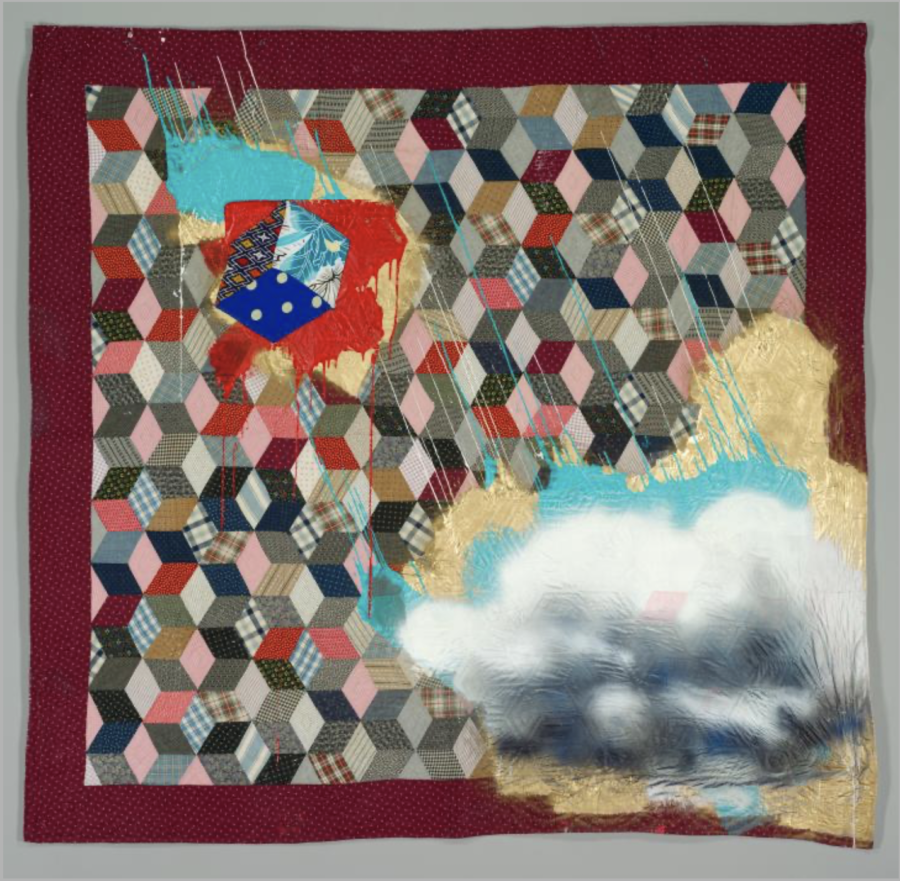“Currents and Constellations: Black Art in Focus” sets new standard for narrative art exhibits
The CMA’s new exhibit, “Currents and Constellations: Black Art in Focus,” highlights Black artistic production, including Sanford Biggers’ “Cumulo” (above), which alludes to enslaved people using quilts with embroidered instructions to get to freedom.
The Cleveland Museum of Art has become the setting for an exhibition that defies the norms of institutional displays. “Currents and Constellations: Black Art in Focus” takes the idea of an art show and flips it on its head, presenting to its audiences an exceedingly candid look into the worlds of Black artists living and working in the United States. With four satellite exhibits peppered throughout the museum in addition to a main gallery space, “Currents and Constellations: Black Art in Focus” forms a striking link between identity and place while challenging the conventions of the typical museum experience.
The central room of the exhibit—located in the ground floor Focus Gallery—features a peripheral scattering of pieces brought together by the establishment of five discernable themes: “Turning Away,” “Turning Towards,” “The Sacred Mundane,” “Resistance in Black and White” and “Black Cartographies.” Although each work in this space primarily identifies with a single theme, there is a lingering sense that the pieces are all in constant communication, working together to convey a cascading series of tactile messages rooted in individuality, love, pain, community and presence. We can see the ways in which this collection of art fuses together, allowing us to comprehend the vast “currents” of personal expression and thought that identify these works as complex renderings of real-life experiences.
In the center of the gallery, “Forms Carried Aloft, No. 2,” welded in steel by Richard Hunt in 1960, reigns with a delicate but unmistakably naturalistic presence. Its abstraction separates it from the idealised perfection of the human form so consistently found within the chronicles of the artistic canon. The twisted and wrought utterance of the piece is where the parallels of mortal and worldly beauty can be identified. Hanging nearby, Kenturah Davis’ “The Bodily Effect of Color (Ambrose)” (2020) elaborates on the notion of individual voice. The artist weaved together letter stamps and faded shades of ink to create the form of a young woman in the act of turning away, her anonymous face and squared shoulders speaking proudly for her. “Cumulo,” created by Sanford Biggers in 2014, presents a new form of history painting that uses handmade quilts as canvases, a reference to the belief that quilts sewn with hidden instructions were used to guide enslaved persons to freedom via the Underground Railroad. By tying this historical connection back to his family’s tradition of quilting, Biggers expands upon an intergenerational discussion while culling elements of heavenly aspiration and promise.
Four gallery spaces throughout the CMA house additional branches of the “Currents and Constellations: Black Art in Focus” exhibit, merging permanence with the recognition of past exclusions. “I Am Everything That Will Save Me Scale II” from “Bird and Lava” (2021) by Torkwase Dyson and “Winter Branches #4” (1953) by Norman Lewis both play with notions of abstraction, warping keenly recognisable facets of life into elaborate reflections of self. Don Thrash’s innovative “Mr. X” (1937-38) carves a recess into the predominantly white field of art, proving that if necessity is the mother of invention, the desire to build and share identity is the ‘North Star’ of culture. All three of these pieces can be found in the CMA’s Contemporary galleries where they expand upon the Focus Gallery conversation, whispering back and forth with the other works as they shape the murky but ever-present constellations of human connections.
The final, and perhaps most poignant, aspect of the exhibit is the addition of Titus Kaphar’s “Shadows of Liberty” (2016) to the Colonial American gallery. On view alongside a 1779 portrait of George Washington by Charles Willson Peale, “Shadows of Liberty” incorporates standard components usually found in depictions of the first President, but Kaphar does not allow this portrait to be one of idealized grandeur. Forced into the canvas of “Shadows of Liberty” with sharp nails are long strips of yellowed fabric upon which the names of the 300 people enslaved by George Washington have been etched in careful cursive. Nearby, a “Male figure (nkisi nkondi)” statue from the Democratic Republic of Congo serves as inspiration for the painting: the rusted nails hammered into its small wooden body represent the sealing of sworn oaths and empowerment through aggression. Kaphar’s “Shadows of Liberty” peels back a corner of white-washed, sanitized American history while restoring a small dose of the honor indebted to those who were for so long denied the right to their identities.
There is no end to the ways in which art can be used for experimenting with identity. The artists represented in “Currents and Constellations: Black Art in Focus” have looked to the past for guidance, whether it be to the historical canon and the infinite figures housed within it to whom we have affixed honor, or to the records of personal and social history that are wreathed with emotions and inscribed memories. “Currents and Constellations: Black Art in Focus” will be on display until June 26 and is open to all visitors.


